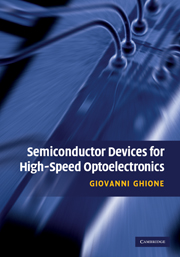5 - Sources
Published online by Cambridge University Press: 03 February 2010
Summary
Optical source choices
Two solid-state optical sources are currently available, the light-emitting diode (LED) and the laser diode (LASER stands for light amplification by the stimulated emission of radiation). LEDs have poor spectral purity and low speed under direct modulation, and are therefore unsuited to long-haul or high-speed communication systems.
Lasers, on the other hand, have at least one order of magnitude narrower linewidth than LEDs and, under direct modulation, can reach bit rates in excess of 10 Gbps (albeit with some deterioration of the spectral purity due to the spurious frequency modulation or chirp associated with the amplitude modulation). Lasers are therefore well suited for long-haul and high-speed applications, although indirect modulation is required to achieve bit rates in excess of 10 Gbps over long distances (e.g., L > 10 km).
Light-emitting diodes
Light-emitting diodes (LEDs) are based on electron–hole (e-h) pair recombination in a forward-biased pn junction or heterojunction, leading to spontaneous photon emission. Due to the emission mechanism, the LED output spectrum is comparatively broad (with a total width at half power of the order of 1.8kBT ≍ 47 meV at ambient temperature), or, in terms of wavelength, about 50 nm (or 500 Å) with respect to a central wavelength around 1m. The spectral purity of LEDs is therefore low with respect to lasers, whose linewidth is at least one order of magnitude narrower. At the same time, the LED maximum modulation speed is of the order of 100 Mbps, about two orders of magnitude slower than the laser direct modulation response.
- Type
- Chapter
- Information
- Semiconductor Devices for High-Speed Optoelectronics , pp. 255 - 355Publisher: Cambridge University PressPrint publication year: 2009



